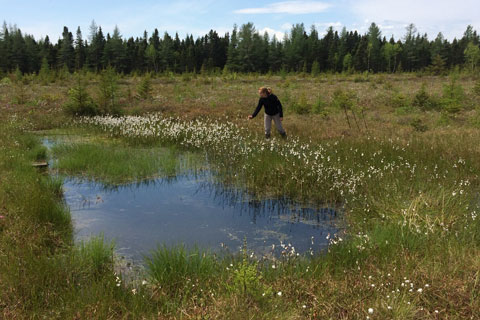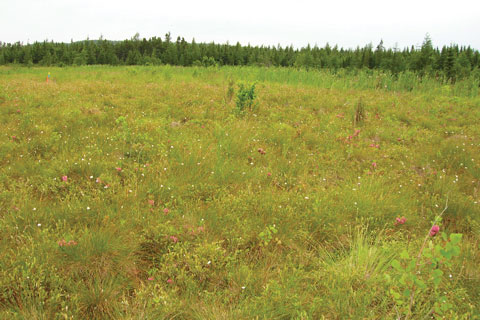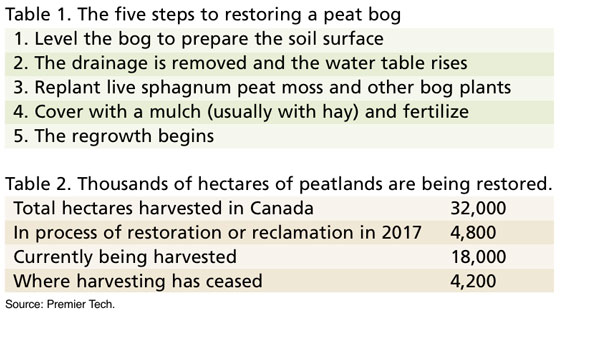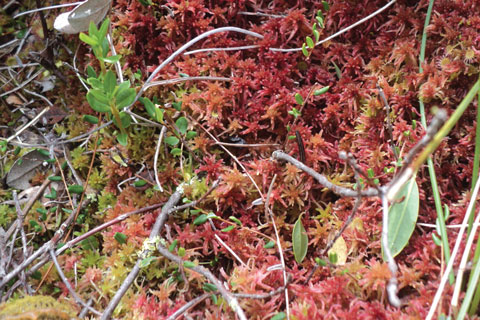1/1/2022
Is Peat Sustainable?
Jennifer Zurko
A lot of the information included in this article is from our October 2021 webinar titled “The Facts on the Sustainability of Peat.” To watch the archived version, go to growertalks.com/webinars.
“What is Peat and Why Should We Protect It?”
“Is This Popular Gardening Material Bad for the Planet?”
“The Real Truth About Peat Moss”
“4 Reasons to Stop Using Peat Moss”
“The Dirty Secret Behind Sphagnum Peat Moss”
If you type in the phrase “Is sphagnum peat moss renewable?” in Google’s search bar, these are the first headlines that pop up. Which explains why this topic has become a bit controversial with environmentalists and conservationists, and in turn, has become a sticking point for growing media suppliers and growers.
As growers and suppliers become more aware of the impacts their products and services have on the environment—and as consumers are becoming more climate-conscious—more focus is being put on inputs like peat moss. The debate on how renewable peat actually is also has been fueled by opposing political views and opinions.
But how “bad” is harvesting sphagnum peat moss, really? Will the Canadian peat industry that North American horticultural producers have long relied on for decades end up like Europe, with bans and mandatory phase-outs (see Sidebar 1)?
A quick peat recap
Susan Parent is Premier Tech’s Horticultural Specialist for Eastern Canada and the Northeastern U.S., and she’s been with the company for 35 years, amassing a vast knowledge of the production and restoration of sphagnum peat moss. Premier Tech itself has been involved in the harvesting and supplying of peat for just about 100 years.
Susan said peat is a “primitive type of plant, but also very sophisticated.” There are many different types of peat moss, but the one we’re most familiar with in our industry is from the genus sphagnum.
There are 160 different species of sphagnum peat moss. What characterizes sphagnum peat is that it naturally accumulates near bodies of water and it’s been doing that for almost 10,000 years when the glaciers receded after the Ice Age. It commonly grows by black spruce forests where acidic soil, cold weather and a lot of rain offer the ideal environment for sphagnum peat moss to thrive.
 It does grow slowly—about 4 to 6 in. (10 to 15 cm) with a 1 mm (1/8 in.) spread per year. But it’s very adaptable. And small, but mighty—even sometimes “pushing” trees out of the area because it’s so competitive for water. Yearly accumulation of new peat is 20 million tons, with 1.38 million tons being harvested in North America each year.
It does grow slowly—about 4 to 6 in. (10 to 15 cm) with a 1 mm (1/8 in.) spread per year. But it’s very adaptable. And small, but mighty—even sometimes “pushing” trees out of the area because it’s so competitive for water. Yearly accumulation of new peat is 20 million tons, with 1.38 million tons being harvested in North America each year.
Pictured: Dr. Line Rochefort, a Canadian scientist specializing in peatland ecology, monitoring a restored peat bog. Photo courtesy of Asha Hingorani.
Sphagnum peat comes from northern temperate zones, which is why Canada is the perfect place for peat to grow. There are 114 million hectares of Canadian peat resources, with only about 32,000 hectares (60,000 acres) being used for harvesting during the past 90 years, so less than 1% (0.03%) is being currently used. Thirty to 50% of the world’s wetlands are peatlands and a lot of that is in Canada. (Other countries with large swaths of peatland are Finland, Sweden, Denmark, Ireland, Malaysia and Indonesia.)
In Canada, 81% of the peatlands are “virgin peatlands” that have remained untouched. After that, 15% is used for agriculture and then other uses (including harvesting for horticulture, urban development and forestry) is less than 1%.
“We could say, ‘We have lots of resources here,’ and that could be our attitude,” said Susan. “But that’s not quite how we see it. Even though it’s very little that we’re harvesting, we see it as something very, very precious. It’s important to preserve it—especially for the generations ahead.”
The horticulture industry started mixing sphagnum peat moss into its growing media in the 1960s. And it’s been a key soil amendment for years and years because the properties of peat moss have always provided a consistent and reliable product for growers, for everything from ornamentals to edibles to cannabis, explained Susan.
“Like we say in the industry, peat is a bit of an enabler,” she said. “It allows the other additives in the growing media to do their job.”

Management and restoration are the keys
One of the reasons why advocates for sphagnum peat moss consider it to be sustainable is because, if managed properly, it can be a renewable resource. For over 30 years, peat suppliers in the hort industry have been the driving force in managing and restoring peat bogs responsibly. There have been a lot of innovations in technology and advances in research that have allowed peat suppliers to continue to offer peat as a product, while also being good environmental stewards.
Pictured: A restored peat bog. Once a bog is restored, it is never harvested from again. Photo courtesy of Susan Parent.
“From the start, the industry came up with best management practices and guidelines. A bit like they have in the wood industry,” said Susan. “We wanted to have something that would make us ahead of our time. Thirty years ago, you didn’t hear as much about climate change as you do now.”
The goal is to always preserve as close to 100% of the peatlands as possible, said Susan. There’s still that 0.03% that they continue to harvest and they understand that there are some carbon emissions that come with that. But what’s important to know—and as more research is being conducted—is that as trees and plants are being produced in this peat-based media, a certain amount of carbon is being sequestered out of the environment.
“What we’re always looking at is how can we minimize the impact,” Susan explained.
The peat suppliers, through the Canadian Sphagnum Peat Moss Association (CSPMA), have had a decades-long partnership with a number of Canadian universities to help research the best tools and methods that would give them the chance to figure out how to manage peat bogs.
Some of the approaches that are being used to manage peatlands sustainably are:
• Restoring harvested peat bogs and conserving “virgin” bogs to help re-colonize the environment (see Table 1)
• Follow imposed best management guidelines (by the suppliers, the CSPMA and Canadian regulations)
• Participate in energy-reduction programs and continue to find new ways to reduce used energy
• Strive to be certified—Veriflora offers a Responsible Peatland Management certification (more than 80% of the production for North America is from Veriflora-certified Canadian peat moss producers)
 “The Certification for Responsibly Managed Peatlands—an international first—guarantees the application of good management practices in all aspects of sustainable development,” explained Asha Hingorani, President of CSPMA. “The program is administered by an independent certification agency, the Scientific Certification Systems, which is one of the most recognized agencies in North America.”
“The Certification for Responsibly Managed Peatlands—an international first—guarantees the application of good management practices in all aspects of sustainable development,” explained Asha Hingorani, President of CSPMA. “The program is administered by an independent certification agency, the Scientific Certification Systems, which is one of the most recognized agencies in North America.”
Asha said that the certification program was developed in 2012 in collaboration with CSPMA and the Québec Peat Moss Producers Association, representatives of the U.S. and Canadian governments, academic experts and horticultural peat producers. It’s evolved into a full certification review process, making it a full-fledged standard, incorporating the latest scientific knowledge and industry’s best practices.
In 2016, the industry adopted the National Peatland Restoration Initiative (NPRI), with the primary goals of a 30% reduction of the historical non-restored areas within the next five years and a target of 100% reduction after 15 years. Within the first four years of the NPRI (2016 to 2020), members have reduced the historical non-restored areas by 28%, said Asha.
There’s also been the development of a world-renowned restoration process for sphagnum peatlands, called the Moss Layer Transfer Technique (MLTT), that allows producers to renew the ecosystem and provide a vast environment for the biodiversity of peat bogs to return (see Table 2.)
Harvested bogs are allowed to re-flood and then seeded with shredded peat “grafts” that grow together. It takes about five years for the moss to cover the site and 10 to 15 years for the bog to go back to its natural condition.
“To this day, we don’t go back to the restored bogs,” stated Susan. “We let nature take its course.”
Susan said harvest numbers have been about the same during the last few years. The idea is that the suppliers want to be as sustainable as possible, so they don’t just go into a bog and start harvesting without looking at the whole, big picture.
“I think so far, even with the increase in demand in growing media in edibles and the marijuana market, we’ve been able to satisfy those markets [without much increase in production] and we hope that continues,” said Susan.
Strict regulations on a renewable resource
Depending on which Canadian province you live in, the regulations surrounding peatlands can slightly differ. But all have strict requirements and compliance guidelines, including permitting, when it comes to harvesting and maintaining a peat bog.
“The Canadian industry is highly regulated provincially across Canada,” said Asha. “Producers and CSPMA work closely with the government at all levels to ensure all checks and balances are in place.”
 Asha said all of the suppliers and associations are constantly educating government officials and stakeholders on the important role peat plays in providing food security and well-being across North America. And the Canadian government recognizes that the industry works to manage all of the peatlands responsibly. At the start of the pandemic in 2020, the government and its provincial counterparts viewed the industry as essential, so it appears that there’s an understanding of the importance of peat and its producers.
Asha said all of the suppliers and associations are constantly educating government officials and stakeholders on the important role peat plays in providing food security and well-being across North America. And the Canadian government recognizes that the industry works to manage all of the peatlands responsibly. At the start of the pandemic in 2020, the government and its provincial counterparts viewed the industry as essential, so it appears that there’s an understanding of the importance of peat and its producers.
Pictured: A close-up of what sphagnum peat moss looks like. Photo courtesy of Susan Parent.
Still, the peat industry has their doubters and nay-sayers. As I mentioned at the start of this article, if you just Google “peat” and “sustainable,” most of what you get is negative information. Social media helps to spread the negativity and fan the flames, while the peat bans in parts of Europe and the UK provide the fuel.
Because of the current environment of divisive politics and opinions, Asha said it’s even more vital that members of the peat industry educate key audiences with the facts and highlight their continuous restoration efforts.
“What needs to be understood is that in regard to our social impact, the peat industry has provided generational jobs for decades in many rural communities across Canada,” she explained. “Further, all known growing media components come with advantages and disadvantages—peat brings more net benefits.
“And it’s important to understand that in North America, peat is only used for horticultural purposes.”
The real threat to peat
Whenever we hear about a peat shortage or the concern about availability, the reason is always because the weather wasn’t conducive to harvest enough for that year (see Sidebar 2). There’s a 30 to 40-day window during the summer when peat can be harvested and it’s very dependent on the weather. If there’s been too much rain, the equipment (which acts like a large vacuum) can’t go out into the fields because it’ll cause compaction, making it more difficult to harvest the bog.
So what researchers and peat producers are really seeing is that the threat to North American peatlands isn’t overharvesting, but climate change.
“Extreme weather events can have an impact on restoration, especially if it is right after the work is done, when the plants are not well established,” said Stéphanie Boudreau, CSPMA’s Science Coordinator. “On the other hand, to date, our research has shown that restoration is resilient to disturbances, such as moderate fire, once the plant is well-established. However, we do not know the effects of longer-term climate change or whether there are thresholds beyond which restoration would be compromised.”
“For northern Canada, the climate change scenarios predict warmer, but also wetter, growing seasons—which is good for sphagnum growth,” said Dr. Line Rochefort, a Canadian scientist specializing in peatland ecology. “So the near future scenarios (2020 to 2050) should be rather favorable to the success of peatland restoration when peat mosses are reintroduced.”
Where climate change really causes issues is nearer to the low-lying coastal bogs that are surrounded by the ocean, like in the Acadian peninsula in New Brunswick. Dr. Rochefort said that, there, the problem is the average sea level rise from melting arctic ice and glaciers caused by global warming. In extreme weather events, ocean water floods over natural barriers (like sand dunes or sand bars) and contaminates the restored peatlands with salt water, in which sphagnum peat moss doesn’t survive.
“We have adapted our restoration approach by the means of favoring tidal marsh plants (like planting Carex paleacea) to first stop any peat erosion and runoff,” she said. “That’s second to recreating a wetland, as restoring any moss-dominated peatland is impossible [after it’s contaminated by salt water].”
Renewable … but irreplaceable?
“I think peat moss will never be replaced totally, but we are looking at other additives,” said Susan.
Premier Tech has been marketing coco fiber-and-peat mixes, along with other types of fibers and wood, including pine bark. And there are other media and amendment suppliers that offer alternatives to peat with similar properties, like HydraFiber, for example.
But because many growers still rely on peat for their growing media, and the Canadian peat industry is dedicated to restoring and maintaining the peatlands, it will be available for the long-term.
Susan quoted Dr. Maria Strack, a biochemist at the University of Calgary and one of the research partners, who said, “The peat moss industry is here to stay for generations to come with wise use and renewable peatland management.” GT
If you’ve heard rumblings of peat being banned in parts of Europe and the United Kingdom, here’s what’s happening now: Last year, the UK announced it would require all garden centers that sell peat-based growing media to stop offering the products by 2024. This mandatory requirement started out as voluntary with the hope that garden centers would pull them from the shelves on their own by 2020. But when the pandemic hit and the increase in gardening went through the roof, only about 20 retailers said that they had removed peat-based products from their stores.
With the slow reaction to the ban at the retail level, it’s not clear how it will affect commercial growers, who are supposed to stop using peat-based growing media by 2030.
Since peat bans in the UK have been discussed for years, growers had already started making plans for using alternative amendments. Keep in mind that peat use in Europe is different than in North America. Dried peat has been used for centuries as fuel in some parts of Europe that didn’t have access to coal, oil or gas and the practice has contributed to the release of a significant amount of CO2 into the atmosphere. (To date, only Ireland and Finland still use peat for fuel, but they’re working on phasing this out.)
Peat bogs are slow to restore. Plus, there just isn’t enough land in the UK and the European continent to dedicate to peat bog restoration. Hence, the inevitability of the UK going away from peat moss use.
“There’s a lot less peat available. And, unfortunately, it was extracted heavily for many years, so the environmental situation called for a control to the extraction of peat moss in Europe,” Susan Parent explained. “But the case to do this in Canada is not there. It’s very important to note that it’s only used for horticulture.”
Canadian Harvest of Peat Moss as of August 2021
The Canadian Sphagnum Peat Moss Association (CSPMA), whose members represent more than 80% of the North American peat production, surveyed its members on the status of their 2021 Actual Harvest as a percentage of their 2021 Expected Harvest on August 31, 2021.* The harvest overall varied regionally, differentiating between Eastern and Western Canadian harvest areas. Eastern harvest areas were below the industry expectations, while in the West, the harvest exceeded or fully achieved industry expectations.
In Western Canada (Manitoba, Saskatchewan and Alberta), all regions met or exceeded targeted volumes (Manitoba, 102%; Saskatchewan, 109%; Alberta, 108%). Spring was relatively early and reasonably dry in all three provinces enabling a good start. A significant, and in some cases, record-breaking heat and drought period across Western Canada extended through much of the summer and into early fall 2021. These favorable conditions supported the positive results.
In Manitoba, weather conditions (including provincially mandated fire watches) limited harvest and plant operations, constraining capacity. Industry and Government of Manitoba officials are now working on a protocol regime to deal with potential future extreme conditions.
In New Brunswick, both North and South regions were below-expected harvest volumes (New Brunswick North, 80%; New Brunswick South, 76%). Varied weather patterns combined with the late start and the remnants of Hurricane Ida constrained harvest throughout the Maritimes. The harvest on Québec’s South Shore (97%) and North Shore (80%) were below expectations. Several summer storms, particularly on the north shore, did not permit either region in achieving their targeted volumes. Similar weather patterns affected the Ontario (87%) harvest.
South of the border, Minnesota (79%) experienced a lower-than-expected harvest because of weather patterns.
—Source: CSPMA
*Actual Harvest: The volume of cubic feet of harvest that corporately was achieved as of August 31, plus what can reasonably be expected to be harvested for the last few weeks of the season considering “normal” harvesting conditions. Expected Harvest: The volume of cubic feet that equates to a) market needs; plus b) anticipated buffer as at the end of the 2021 season; minus c) inventory on hand at the start of the 2021 season (what was left of the 2020 buffer).